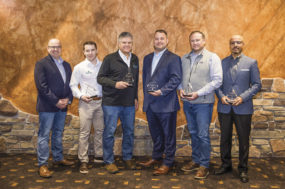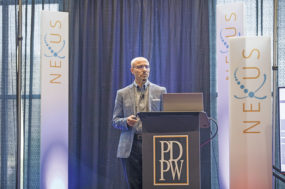Early this spring, an engineer with the Ministry of Water Resources (MoWR) invited me to visit his experiment station.
Dr. Kamil M. Muhammed obtained a doctorate in irrigation management and holds a civil engineering license. He is my age, with three children, two of whom are medical doctors and one is in medical school.
I asked my linguist, Dr. Al Shabibi, to visit the site with me. He agreed. We obtained a security clearance after some convincing that the visit was mission critical status. The experiment station is called Al Raaid, which approximately can be translated into the "pioneer" or lead station. We call it ARES, and it is the topic for this article.
Our visit was insightful. We toured the laboratories, the equipment yard, the test plot areas and the two weather stations. We conducted an I & E (inventory and evaluation) at the request of the ministry. Our report was quite telling: the ARES has a fully developed infrastructure in terms of buildings, land, a diesel generator and a well-trained staff. What it lacks, however, are tools to accomplish their mission. Their mission mirrors experiment stations in all parts of the world, including the U.S. They develop applied and field-based management tools, techniques and methodologies that will help landowners and farmers increase crop yield, improve profit and adopt conservation and efficiency practices.
For the ARES, Dr. Kamil reports three research goals. One, develop water consumptive use factors for cereal and vegetable crops; two, understand the relationships between saline soils and saline irrigation water; and three, identify crop salt sensitivity. Any one of these is an extraordinarily large goal, but three certainly will challenge any station manager.
The ARES is less than fully functional. The best instrument on the facility is a Campbell Scientific Weather Station, a research-grade set of instruments with both above- and below-ground monitors. The data logger is downloaded daily, and the data written in an Excel spreadsheet and distributed to engineers and scientists in other MoWR facilities. I am not sure how the data are summarized or the extent of distribution. The data sheet I read included the typical weather phenomena used to calculate reference evapotranspiration, or ET sub r.
Dr. Kamil and I have been meeting weekly for the last three months. We are developing both a tactical and strategic work plan for the station. We have built a list of equipment and service items to complement the infrastructure already on site. We will be submitting the work plan, budget and request for funding to the Multi-National Corps-Iraq (MNC-I). The MNC-I are essentially military personnel conducting civil affairs. Their mandate is development, whilst ours is diplomacy.
This linkage is important. Given the complexity of our strategic mission here (defense, diplomacy and development) the U.S. government is committed to use the military and civilian assets wisely. Our tactical objective is downsizing our presence here in Iraq, and strategically, we are developing enough of Iraq so that the government of Iraq (GOI) can carry on without us. To do that, U.S. taxpayer dollars are earmarked for projects here and will be spent if they can develop, rebuild and enhance portions of the government that are critical for Iraq to function. This is a huge task. And certainly there are multiple ways and methods to get this done.
Our role here (in part) at the U.S. Embassy is coordinating the military funding with projects that we think are essential. Yes, this work is subjective, and certainly based on our own biases and experiences. We get paid to make these decisions, and they can involve large sums of money. My take on this is simple: get as much return on investment as possible. I too wrestle with the amount of money spent here in Iraq when we have plenty of needs in the U.S. We are told that as we downsize here, the funding will as well. Interestingly, I can write here that much of the developmental funding is shifting to Afghanistan. The mission there is in the popular press nearly on a daily basis, both in terms of military and civilian efforts. I often reflect back to my year in Afghanistan, in 2006, wondering what is different and what still might be the same.
I am ending this article on a more personal level, and that is to describe for you something about the work in diplomacy. In the context that I am an agricultural scientist, I rarely use science here in the strict sense. Rather the work here is RB, or relationship building. In my six months here in Baghdad, I have met many colleagues in several ministries. As in any workplace, we form alliances and partnerships with others so that we can move forward. The collective good is our goal.
I often find myself preferring colleagues with a big picture outlook ... men and women with a vision for the future and the sense to know that it takes a lot of hard work, time and money to implement this vision. Often they are interested in true development rather than self-aggrandizement or self-promotion. Dr. Kamil immediately impressed me with his desire and vision. He is a leader in many ways. For instance he clearly recognizes that the mission of ARES is vital for Iraqi agriculture at the field and farmer level. He is mentoring several graduate students from Baghdad University. These students are using his station for not only their academic development, but learning the importance of technology transfer. Their work is delivered to landowners and farmers in a basic format ... not an academic paper few can understand.
Dr. Kamil has a vision for Iraqi agriculture. He understands the importance of having younger scientists on staff, well trained with the tools to do their work. He believes in the words "can do" rather than the word "can't." Because this approach is directed towards the future of those he serves rather than to himself, I am going to help him if I can.
On a very warm Tuesday morning, we met at the Al Rasheed Hotel, located in the International Zone. We typically meet here. The security logistics of meeting at the ARES are difficult; the station is in Abu Ghraib, a particularly dangerous area that is on the outskirts of Baghdad and home to the famous prison there.
We talked over the request for funding and the possible outcomes of approval. He happened to bring along his dissertation, done a number of years ago. Like me, he went back to school in midlife and earned a Doctorate degree. The published dissertation was bound in red, bright red. The document was written in Arabic, which means starting at the back of the book, and reading right to left. The cover page was in English, as was the abstract.
We spent a half hour discussing his work (all scientists and engineers love talking about their work). We drank black tea and then agreed on our next meeting time and place. I called for my driver and he walked through the first security checkpoint.
I do know this. When my TDY assignment is completed in February 2010, the ARES renovation may be in the implementation phase. I hope so. But regardless of its status, I have met an engineer and we will be friends and colleagues for the rest of our lives. PD
Mike Gangwer
USDA Adviser
To contact Dr. Gangwer,
e-mail him at GangwerMI@state.gov




